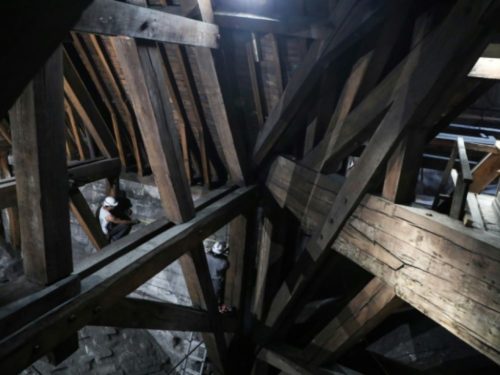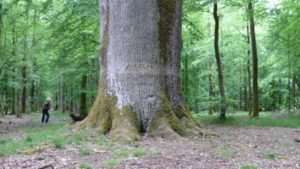Remember the satisfying thunk when you strike a nail squarely with a strong hammer blow and the nail sinks an inch into wood? Few metaphors are as sound and accurate as “hitting the nail on the head”. Forgive the boast, dear readers, for a post Mike O’Hare and I made here five years ago proposing more building in wood as a way of cutting carbon emissions. There is a nifty new technology (engineered wood beams and panels) that makes it much easier; trees fix carbon, and using the wood in structures extends the sequestration for decades.
Dave Roberts at Vox has a long new post up making essentially the same points. With more recent data, he has better and higher estimates than ours of the potential savings in carbon emissions. The other news is that things are beginning to move, as wood is transitioning from a handful of bespoke prestige projects to routine use in large buildings.
I thought the trendsetter would be New Zealand, which is heavily forested and has innovative wood structural engineers. But it’s small (4 million population), remote, and does not export much timber. No, it’s Canada; specifically British Columbia, the centre of the large Canadian forestry industry.
A mundane timber-framed 18-storey block of student rooms, Brock Commons, in Vancouver. The concrete stairwells are presumably required for fire safety.
BC has changed its building code to allow 12-storey wooden buildings routinely, and its code has been copied in the rest of Canada. Three are 500 mid-size wooden buildings under construction across the country. The new standards have spread to China and now much of the USA. US building codes are a local or state responsibility, but they often rely on common models, which now allow engineered wood.
The caveat to the RBC paean is that to get the full benefit, the forest management has to be based on forests that are (1) sustainably managed (2) second-growth. In BC, the timber building movement runs into nuanced criticism from defenders of the splendid old-growth forests. There is no inherent conflict here: engineered wood can perfectly well use fairly small pieces of lumber, such as those you get from smaller second-growth trees (in parts of Europe, eighth-growth), or 40-year thinnings, glued together in factories into panels and beams of the required size. But the lumber industry is what it is, and greater demand poses a threat to old growth worldwide unless its appetite is restrained by firm government and honest regulation. This will be a battle in the Pacific Northwest, and an even bigger one in tropical Africa and South America.
Endnote 1: the inventor of cross-laminated timber
Dave Roberts credits Austrian Gerhard Schickhofer, a professor at Graz Technical University. Alpine forestry is necessarily conservative; prevention of landslides and avalanches has priority over wood yield, and you don’t see clear cuts. Hillside trees tend to be small. This environment encourages a frugal approach to wood use, and lamination is a natural extension.
Endnote 2: Notre Dame
As you all know, the roof of the great Notre Dame cathedral in Paris burnt down in a huge fire in April last year. The roof above the vaulting was supported by massive oak beams, so many that they were known as “the forest”. There were no firewalls or sprinklers in this huge drafty space, an ideal system to keep the flames supplied with oxygen. The rebuilding fund has money: but what to do about the roof?
A very French grand débat has started over this. Suggestions include the wacky (a rooftop open-air swimming pool, an all-glass roof). Nobody will listen to our views but it’s fun to join in anyway.
The baseline restoration scheme is “just as it was before”, including the 19th-century iron central spire. Taken literally, this requires replacing the Forest with new oak beams. Where do you find the trees? The oak forests of France have shrunk since the 12th century, or the 9th when the acorns that generated those beams fell. There are fine oaks like these  planted by Colbert to replace those he cut to build warships for Louis XIV – trees that have preservation orders on them. Even in a good cause, felling a thousand of them is not on.
planted by Colbert to replace those he cut to build warships for Louis XIV – trees that have preservation orders on them. Even in a good cause, felling a thousand of them is not on.
What makes the problem more tractable is that the Forest was not generally open to visitors before the fire. It should be culturally possible to innovate. I’d go for a technically modern roofspace, using a steel space frame or engineered wood, and preserving some of the surviving blackened timbers as a memorial. The space could be made partly usable for religious or cultural purposes, assuming you could put in lifts.
Wood fiber engineered sufficiently to support large structures is a complex and relatively new technology. Not surprisingly there have been missteps.
The new Peavy Hall would symbolize the rebirth of the state’s timber industry by showcasing its signature innovation: cross-laminated timber. With its ambitious use of wood that’s been fortified to rival steel, Peavy Hall would underscore Oregon’s place at the forefront of a revitalized forest products market. …
In March, a 1,000-pound section of the third floor buckled and crashed onto the floor below. Engineers traced the panel’s failure to the glue and determined at least five other panels showed signs of delamination. The closer they looked, the more bad CLT panels they found; by August, at least 85 were marked for replacement.
Peavy Hall made a statement all right: about the risks of new technologies and getting caught up in the enthusiasm of the next big thing. The months of delays, the experts and engineers, and the replacement panels will add millions to the cost of a project that already has climbed nearly 32 percent, to $79 million, since construction began. (https://www.oregonlive.com/news/erry-2018/08/4965f0c7df3495/problems-at-peavy-faulty-timbe.html )
“A relatively new technology”? Schickhofer’s PhD thesis describing it was in 1994. Austria has had national standards since 2002 - 18 years ago. Have you heard of major structural failures in CLT buildings in Austria, Finland, New Zealand or Canada? This looks to me more the problem of not being able to trust American capitalists with sharp tools.
IMHO, replacing Notre Dame’s roof with a glass roof would have been what the builders would have wanted, if they could have gotten it.
They were trying to get lots of light into the building.
Yes. I go into the reasons for this here.